Surface Modification of Silicon Carbide Wafers Using Atmospheric Plasma Etching: Effects of Processing Parameters
Abstract
:1. Introduction
2. Experimental Principles and Device Details
2.1. Plasma Processing Principles
2.2. Experimental Setup
3. Experimental Design
4. Results and Discussion
4.1. Ar Flow Impact on Removal Function
4.2. CF4 Flow Impact on Removal Function
4.3. O2 Flow Impact on Removal Function
4.4. Effect of Processing Power on Removal Function
4.5. Effect of Processing Distance on Removal Function
4.6. Experimental Exploration of Optimal Processing Parameters
5. Conclusions
- (1)
- The Ar flow rate had a small effect on the half-height width of the removal function, and the peak and volume removal rates decreased with an increasing Ar flow rate. Therefore, to improve the volumetric removal rate of the material during processing, the incoming Ar flux should be minimized while maintaining a stable plasma je.
- (2)
- Active F particles are necessary for the plasma etching of silicon carbide wafers, and CF4 is the only source of active F particles. The volume removal rate of the material increased with the CF4 flow rate and then decreased. The volume removal rate of the plasma jet was maximum at an input power of 500 W and an Ar flow rate of 19 SLM, and the CF4 flow rate was approximately 65 SCCM.
- (3)
- The introduction of the auxiliary gas O2 destabilizes the plasma jet, but an appropriate amount of O2 can improve the plasma processing efficiency. When the input power was 500 W, the Ar flow rate was 19 SLM, the CF4 flow rate was 60 SCCM, and the incoming 20–40 SCCM of O2 increased the etching reaction efficiency.
- (4)
- The half-height width, peak removal rate, and volume removal rate of the removal function all increased linearly with an increase in processing power and changed significantly. However, excessive processing power increases the plasma temperature, leading to a rapid increase in the temperature of the silicon carbide in contact with the jet region, and the wafer undergoes deformation by heat or even shattering.
- (5)
- The degree of plasma dispersion increases with the processing distance, such that the diffusion of active F particles to the silicon carbide surface is relatively reduced; thus, the processing distance between the plasma nozzle and the silicon carbide wafer should be less than 5 mm.
- (6)
- Based on the results of the previous experiments, orthogonal experiments were designed to determine the optimal process parameters for the plasma processing of SiC wafers. It was found that the maximum volumetric removal rate of silicon carbide by plasma was achieved when the power input power was 550 W, the processing distance between the plasma torch and the workpiece was 3.5 mm, the incoming Ar flow rate was 15 SLM, CF4 flow rate was 70 SCCM, and the O2 flow rate was 20 SCCM.
Author Contributions
Funding
Data Availability Statement
Conflicts of Interest
References
- Morkoç, H.; Strite, S.; Gao, G.B.; Lin, M.E.; Sverdlov, B.; Burns, M. Large-band-gap SiC, III–V nitride, and II–VI ZnSe-based semiconductor device technologies. J. Appl. Phys. 1994, 76, 1363–1398. [Google Scholar] [CrossRef]
- Frajkorová, F.; Hnatko, M.; Lenčéš, Z.; Šajgalík, P. Electrically conductive silicon carbide with the addition of TiNbC. J. Eur. Ceram. Soc. 2012, 32, 2513–2518. [Google Scholar] [CrossRef]
- Yuan, J.; Lyu, B.; Hang, W.; Deng, Q. Review on the progress of ultra-precision machining technologies. Front. Mech. Eng. 2017, 12, 158–180. [Google Scholar] [CrossRef]
- Zhang, X.; Wang, R.; Zhang, X.; Yang, D.; Pi, X. Research status and development trend of silicon carbide single crystal substrate machining technology. J. MUC Nat. Sci. Ed. 2021, 30, 5–12. [Google Scholar]
- Zhang, Y.-X.; Yang, L.-L.; Gao, W.; Su, J.-X. Cross-sectional microscopy detection technology for subsurface damage of fixed abrasive lapped SiC wafers. J. Synth. Cryst. 2013, 42, 906–910. [Google Scholar]
- He, C.; Yingmin, W.; Bin, L.; Xu, W.; Hao, W. Recent development and perspective of SiC wafer machining. Equip. Electron. Prod. Manuf. 2016, 45, 1–6+54. [Google Scholar]
- Yue, W.D.; Liu, Z.D. Situation and development of fixed diamond abrasive wire cutting technology. Diam. Abras. Eng. 2014, 24, 69–75. [Google Scholar]
- Chen, G.; Ni, Z.; Bai, Y.; Li, Q.; Zhao, Y. The role of interactions between abrasive particles and the substrate surface in chemical-mechanical planarization of Si-face 6H-SiC. RSC Adv. 2017, 7, 16938–16952. [Google Scholar] [CrossRef] [Green Version]
- Murata, J.; Yodogawa, K.; Ban, K. Polishing-pad-free electrochemical mechanical polishing of single-crystalline SiC surfaces using polyurethane–CeO2 core–shell particles. Int. J. Mach. Tools Manuf. 2017, 114, 1–7. [Google Scholar] [CrossRef]
- Yang, X.; Ohkubo, Y.; Endo, K.; Yamamura, K. AFM Observation of Initial Oxidation Stage of 4H-SiC (0001) in Electrochemical Mechanical Polishing. Procedia CIRP 2018, 68, 735–740. [Google Scholar] [CrossRef]
- Liang, H.; Yan, Q.; Lu, J.; Luo, B.; Xiao, X. Material removal mechanisms in chemical-magnetorheological compound finishing. Int. J. Adv. Manuf. Technol. 2019, 103, 1337–1348. [Google Scholar] [CrossRef]
- Deng, H.; Liu, N.; Endo, K.; Yamamura, K. Atomic-scale finishing of carbon face of single crystal SiC by combination of thermal oxidation pretreatment and slurry polishing. Appl. Surf. Sci. 2018, 434, 40–48. [Google Scholar] [CrossRef]
- Chen, Y.; Chen, Y.; Long, J.; Shi, D.; Chen, X.; Hou, M.; Gao, J.; Liu, H.; He, Y.; Fan, B.; et al. Achieving a sub-10 nm nanopore array in silicon by metal-assisted chemical etching and machine learning. Int. J. Extrem. Manuf. 2021, 3, 35104. [Google Scholar] [CrossRef]
- Shi, D.; Chen, Y.; Li, Z.; Dong, S.; Li, L.; Hou, M.; Liu, H.; Zhao, S.; Chen, X.; Wong, C.-P.; et al. Anisotropic Charge Transport Enabling High-Throughput and High-Aspect-Ratio Wet Etching of Silicon Carbide. Small Methods 2022, 6, 2200329. [Google Scholar] [CrossRef] [PubMed]
- Piechulla, P.; Bauer, J.; Boehm, G.; Paetzelt, H.; Arnold, T. Etch Mechanism and Temperature Regimes of an Atmospheric Pressure Chlorine-Based Plasma Jet Process. Plasma Process. Polym. 2016, 13, 1128–1135. [Google Scholar] [CrossRef]
- Paetzelt, H.; Böhm, G.; Arnold, T. Etching of silicon surfaces using atmospheric plasma jets. Plasma Sources Sci. Technol. 2015, 24, 025002. [Google Scholar] [CrossRef]
- Wang, Y.-N.; Hang, L.-X.; Hu, M.-D. Super smooth surface fabrication processes-plasma etching. Surf. Technol. 2008, 37, 51–53. [Google Scholar]
- Song, L.; Dun, A.; Wang, Z.; Wu, L.; Peng, B.; Xu, X. Effects of atmospheric pressure plasma electrode structure on silicon carbide removal function. Chin. J. Lasers 2020, 47, 45–53. [Google Scholar]
- Peng, B.; Dun, A.; Wu, L.; Wang, Z.; Xu, X. Variable removal function in atmospheric pressure plasma polishing. Chin. J. Lasers 2021, 48, 65–75. [Google Scholar]
- Xu, S.; Yuan, J.; Zhou, J.; Cheng, K.; Gan, H. Study of Atmospheric Pressure Plasma Temperature Based on Silicon Carbide Etching. Micromachines 2023, 14, 992. [Google Scholar] [CrossRef]


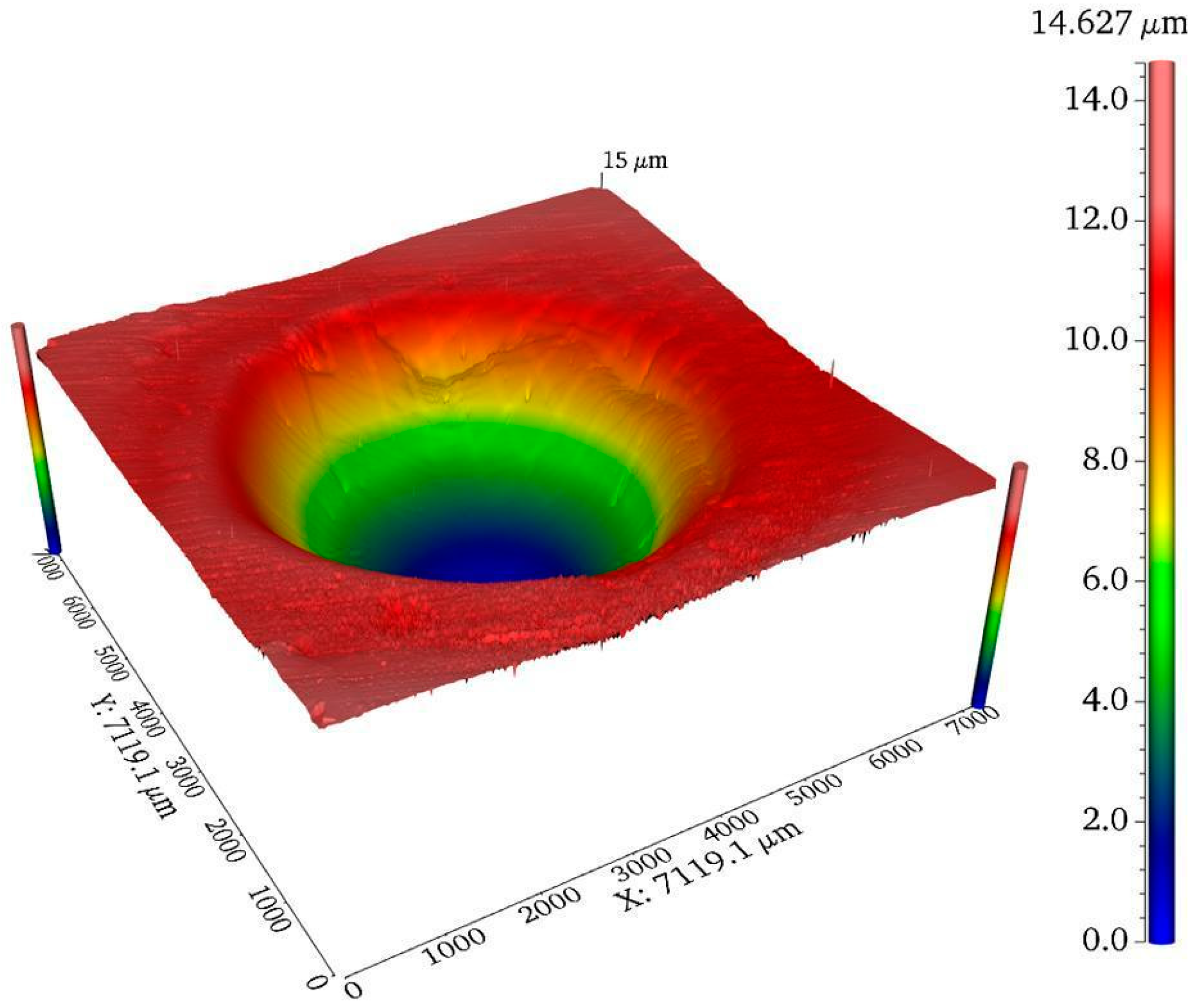

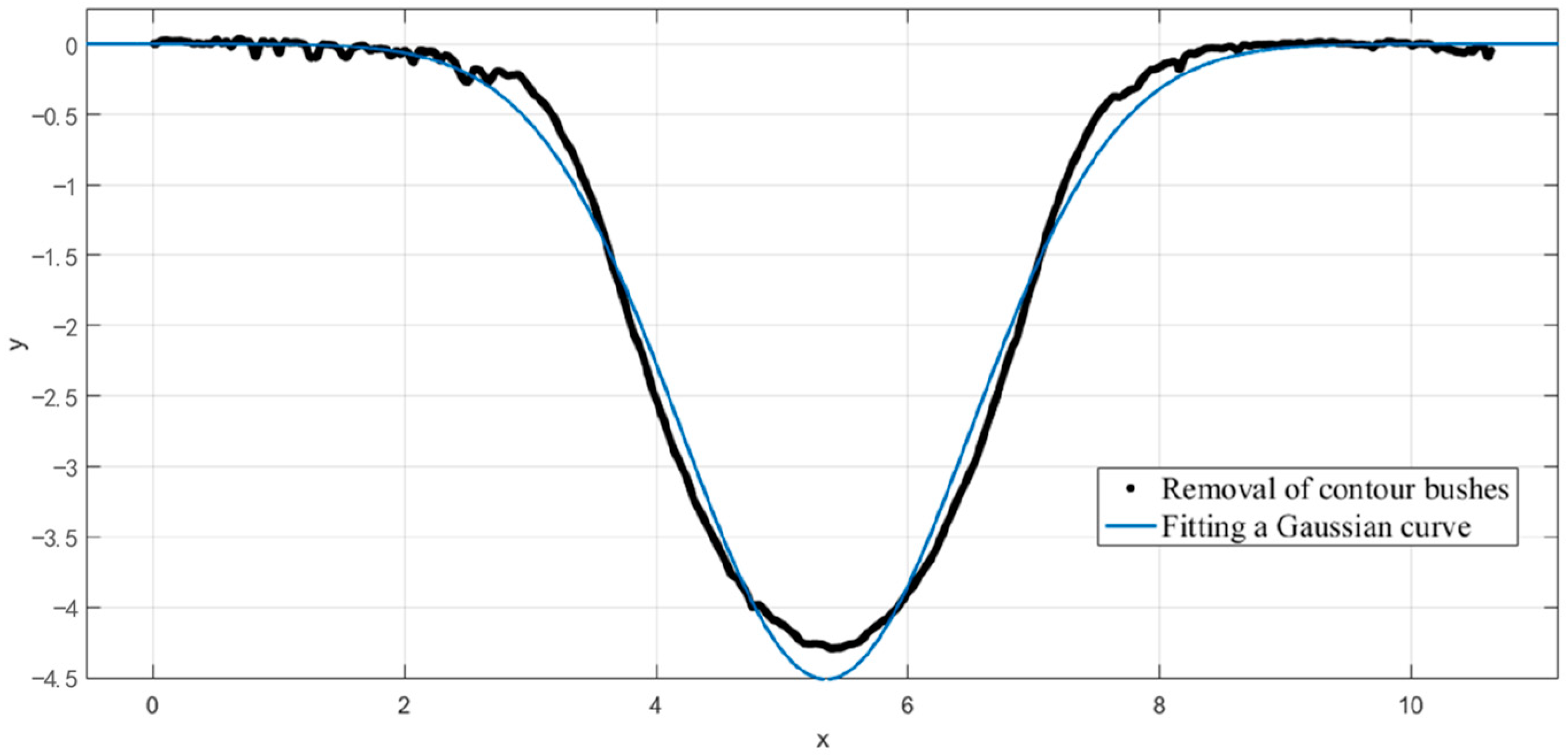
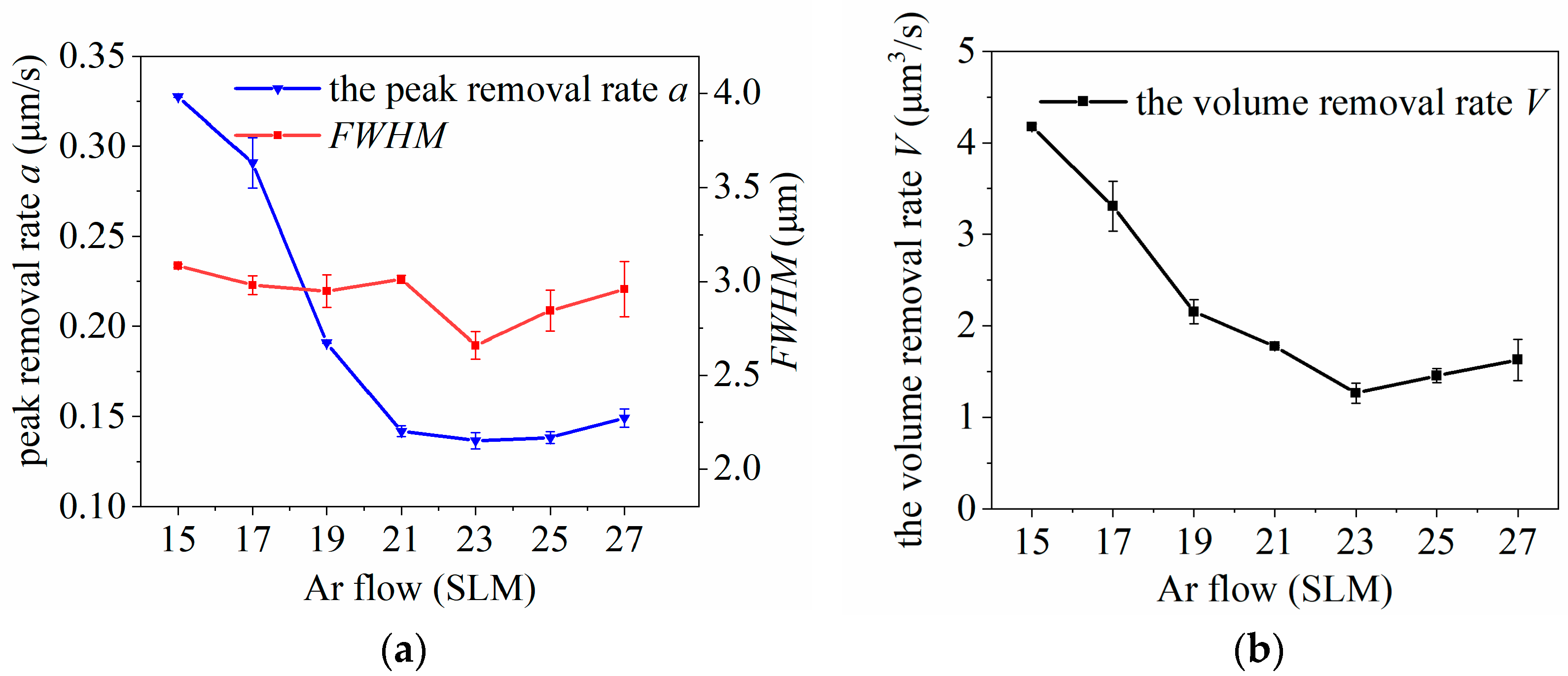
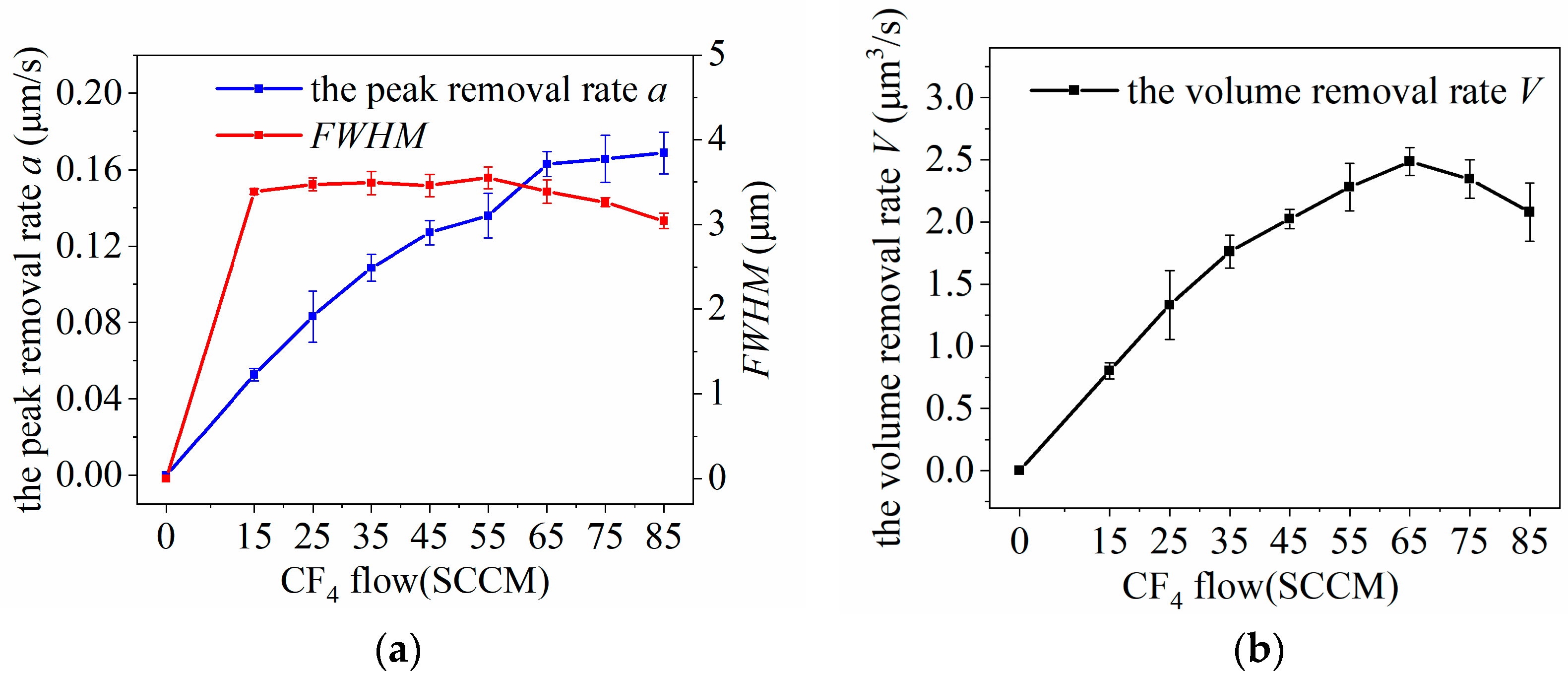


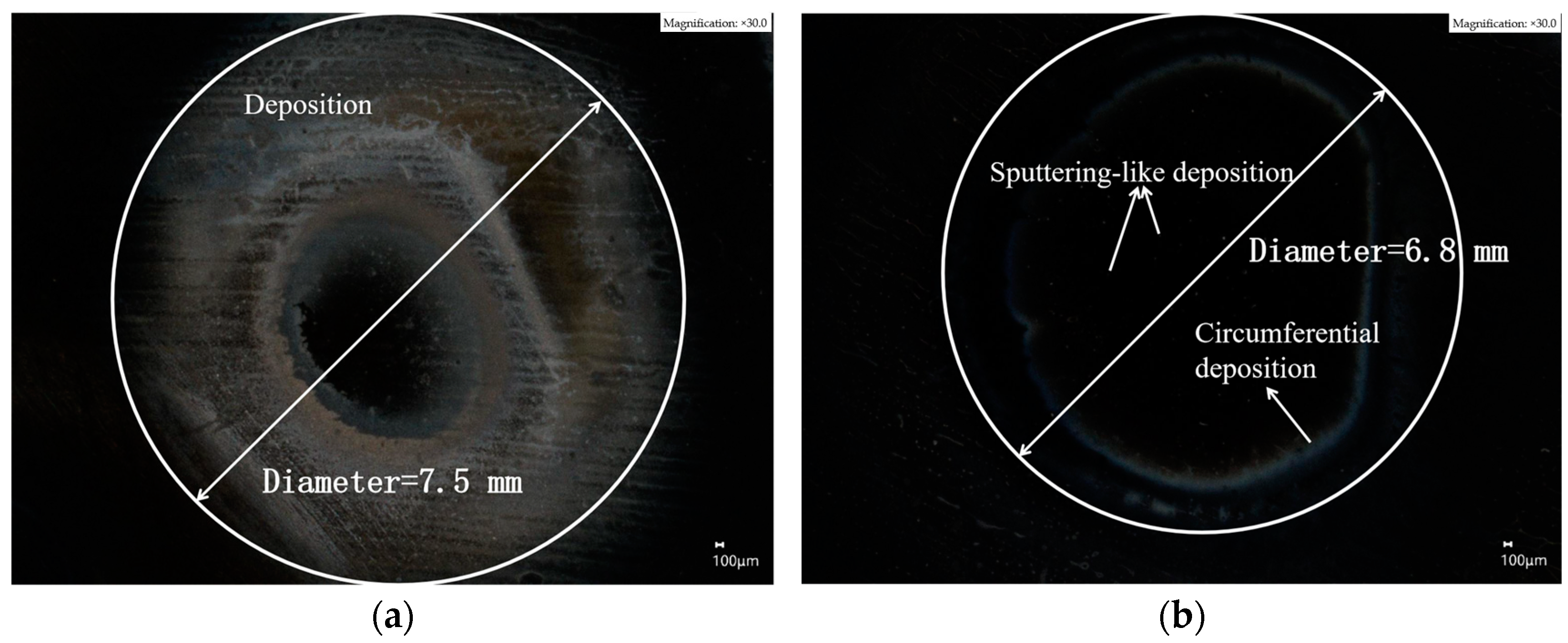

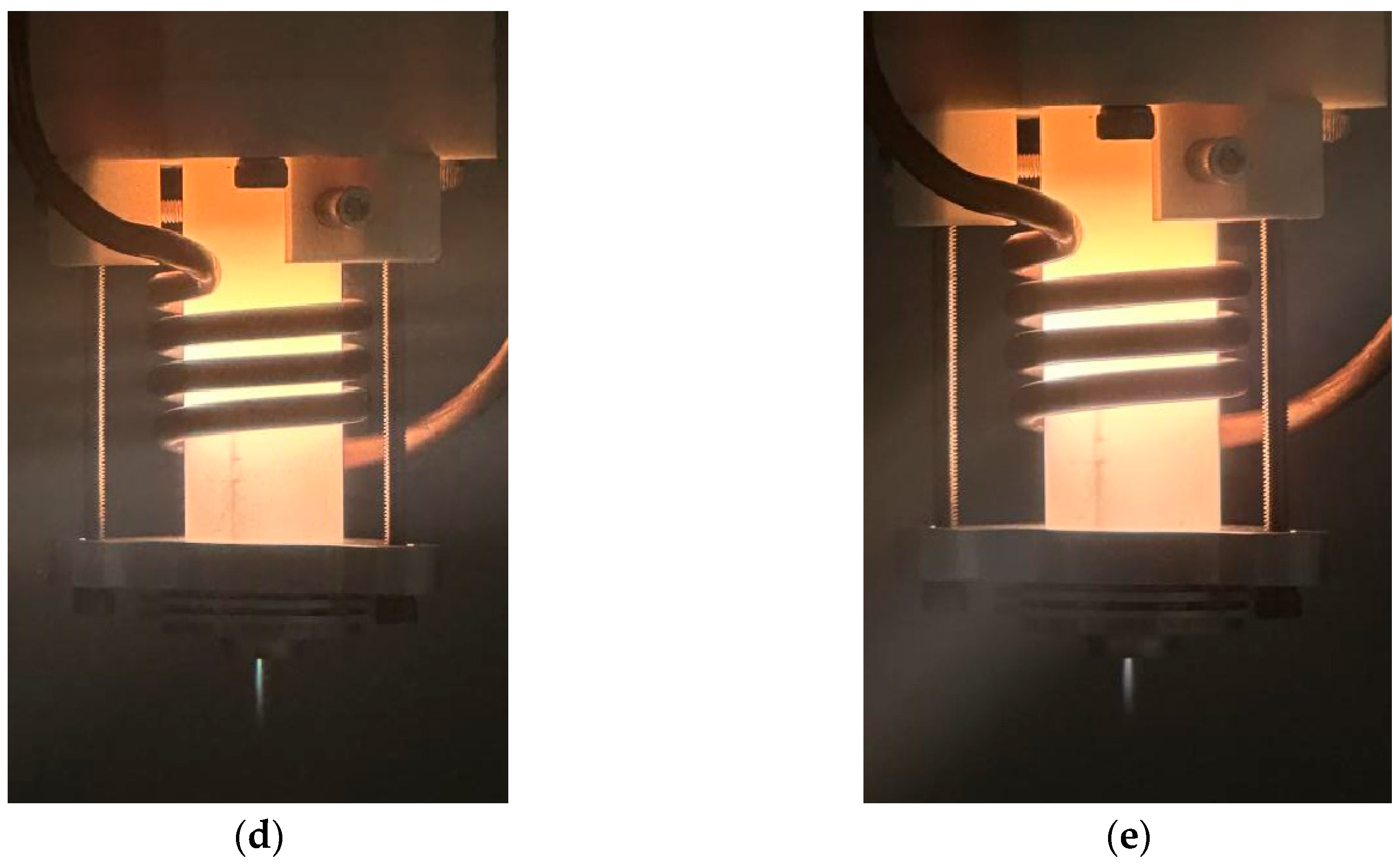
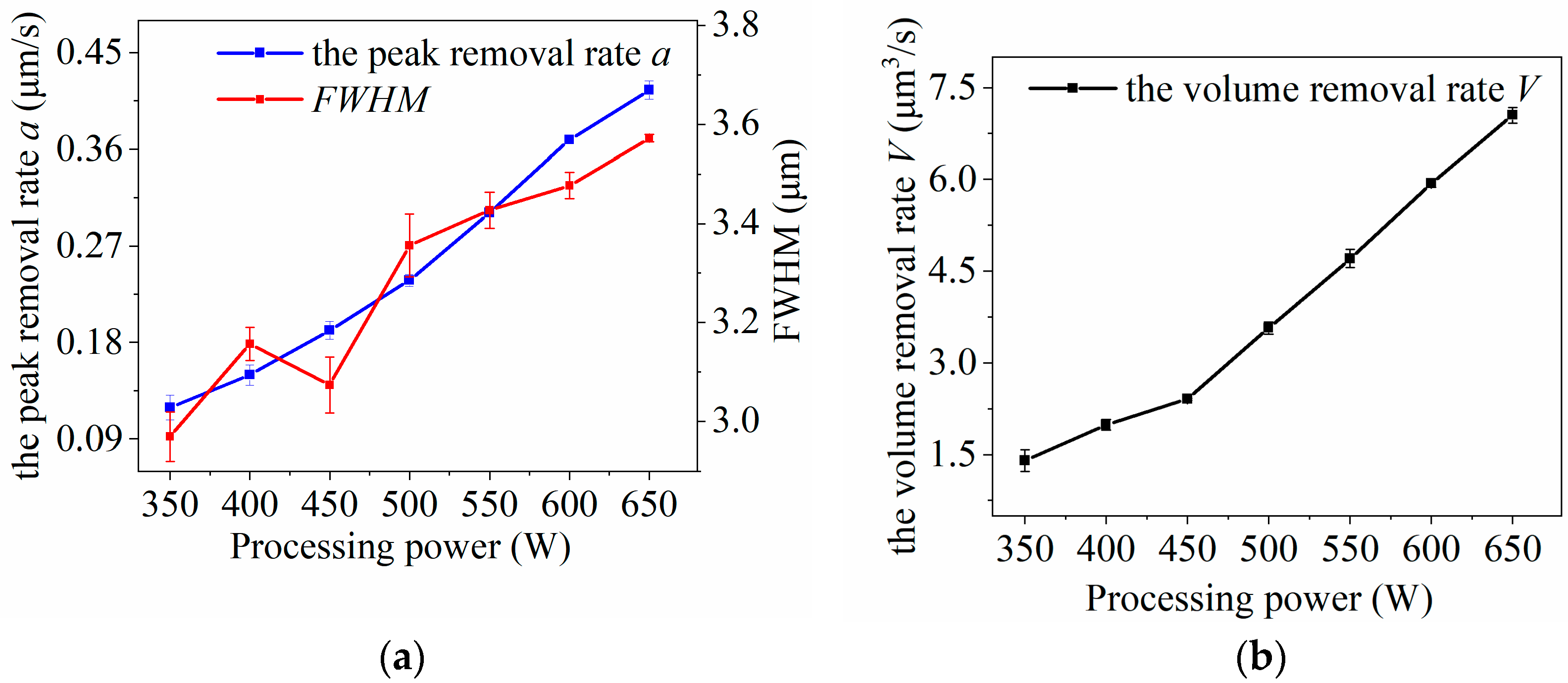
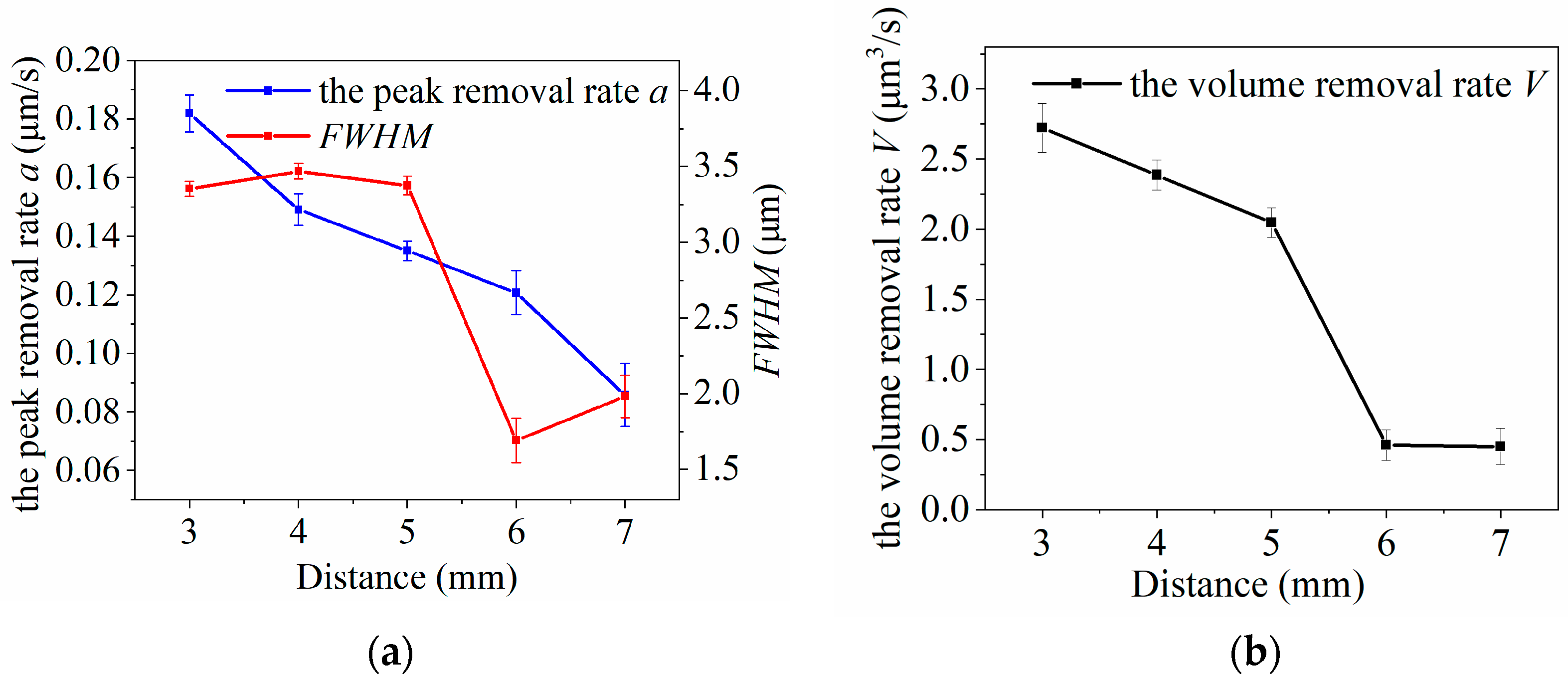



| Ar/SLM | Processing Power/W | Time/s | Processing Distance/mm | CF4/SCCM |
|---|---|---|---|---|
| 15, 17, 19, 21, 23, 27 | 500 | 30 | 4 | 60 |
| Ar/SLM | Processing Power/W | Time/s | Processing Distance/mm | CF4/SCCM |
|---|---|---|---|---|
| 19 | 500 | 30 | 4 | 0, 15, 25, 35, 45, 55, 65, 75, 85 |
| Ar/ SLM | Processing Power/W | Time/s | Processing Distance/mm | CF4/ SCCM | O2/SCCM |
|---|---|---|---|---|---|
| 19 | 500 | 30 | 4 | 60 | 0, 5, 10, 20, 30, 40, 50, 60 |
| Ar/SLM | Processing Power/W | Time/s | Processing Distance/mm | CF4/SCCM |
|---|---|---|---|---|
| 19 | 350, 400, 450, 500, 550, 600, 650 | 30 | 4 | 60 |
| Ar/SLM | Processing Power/W | Time/s | Processing Distance/mm | CF4/SCCM |
|---|---|---|---|---|
| 19 | 500 | 30 | 3, 4, 5, 6, 7 | 60 |
| Number | Processing Power/W | Processing Distance/mm | Ar/ SLM | O2/SCCM | CF4/SCCM | FWHM/μm | a/μm | V/μm3/s |
|---|---|---|---|---|---|---|---|---|
| 1 | 450 | 3.5 | 15 | 30 | 40 | 3.68 | 0.476 | 8.577 |
| 2 | 450 | 4 | 17 | 20 | 50 | 4.526 | 0.221 | 6.026 |
| 3 | 450 | 4.5 | 19 | 10 | 60 | 2.171 | 0.2 | 1.256 |
| 4 | 450 | 5 | 21 | 0 | 70 | 1.932 | 0.14 | 0.697 |
| 5 | 500 | 3.5 | 17 | 10 | 70 | 2.585 | 0.347 | 3.086 |
| 6 | 500 | 4 | 15 | 0 | 60 | 2.951 | 0.275 | 3.186 |
| 7 | 500 | 4.5 | 21 | 30 | 50 | 3.072 | 0.129 | 1.614 |
| 8 | 500 | 5 | 19 | 20 | 40 | 2.734 | 0.144 | 1.435 |
| 9 | 550 | 3.5 | 19 | 0 | 50 | 3.783 | 0.307 | 5.857 |
| 10 | 550 | 4 | 21 | 10 | 40 | 3.072 | 0.246 | 3.095 |
| 11 | 550 | 4.5 | 15 | 20 | 70 | 3.619 | 0.708 | 12.349 |
| 12 | 550 | 5 | 17 | 30 | 60 | 3.142 | 0.341 | 4.485 |
| 13 | 600 | 3.5 | 21 | 20 | 60 | 3.322 | 0.462 | 6.79 |
| 14 | 600 | 4 | 19 | 30 | 70 | 3.444 | 0.566 | 8.932 |
| 15 | 600 | 4.5 | 17 | 0 | 40 | 3.049 | 0.239 | 2.952 |
| 16 | 600 | 5 | 15 | 10 | 50 | 2.857 | 0.395 | 4.287 |
| Processing Power/W | Processing Distance/mm | Ar/SLM | O2/SCCM | CF4/SCCM | |
|---|---|---|---|---|---|
| K1 | 16.556 | 24.31 | 28.399 | 12.692 | 16.059 |
| K2 | 9.32 | 21.238 | 16.549 | 11.725 | 17.784 |
| K3 | 25.786 | 18.172 | 17.479 | 26.6 | 15.717 |
| K4 | 22.962 | 10.904 | 12.197 | 23.608 | 25.064 |
| k1 | 4.139 | 6.007 | 7.1 | 3.173 | 4.015 |
| k2 | 2.33 | 5.31 | 4.137 | 2.931 | 4.446 |
| k3 | 6.447 | 4.543 | 4.137 | 6.65 | 3.929 |
| k4 | 5.741 | 2.726 | 3.049 | 5.902 | 6.266 |
| R | 4.117 | 3.351 | 4.05 | 3.719 | 2.337 |
| Order of Influence | processing power > Ar > O2 > processing distance > CF4 | ||||
| Optimal level | 550 | 3.5 | 15 | 20 | 70 |
Disclaimer/Publisher’s Note: The statements, opinions and data contained in all publications are solely those of the individual author(s) and contributor(s) and not of MDPI and/or the editor(s). MDPI and/or the editor(s) disclaim responsibility for any injury to people or property resulting from any ideas, methods, instructions or products referred to in the content. |
© 2023 by the authors. Licensee MDPI, Basel, Switzerland. This article is an open access article distributed under the terms and conditions of the Creative Commons Attribution (CC BY) license (https://creativecommons.org/licenses/by/4.0/).
Share and Cite
Jin, Q.; Yuan, J.; Zhou, J. Surface Modification of Silicon Carbide Wafers Using Atmospheric Plasma Etching: Effects of Processing Parameters. Micromachines 2023, 14, 1331. https://doi.org/10.3390/mi14071331
Jin Q, Yuan J, Zhou J. Surface Modification of Silicon Carbide Wafers Using Atmospheric Plasma Etching: Effects of Processing Parameters. Micromachines. 2023; 14(7):1331. https://doi.org/10.3390/mi14071331
Chicago/Turabian StyleJin, Qi, Julong Yuan, and Jianxing Zhou. 2023. "Surface Modification of Silicon Carbide Wafers Using Atmospheric Plasma Etching: Effects of Processing Parameters" Micromachines 14, no. 7: 1331. https://doi.org/10.3390/mi14071331
APA StyleJin, Q., Yuan, J., & Zhou, J. (2023). Surface Modification of Silicon Carbide Wafers Using Atmospheric Plasma Etching: Effects of Processing Parameters. Micromachines, 14(7), 1331. https://doi.org/10.3390/mi14071331





